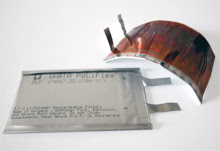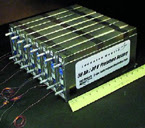A solar battery that automatically recharges gadgets

A story in MIT's Technology Review, written by yours truly, looks at progress in the development of solar batteries for small electronic devices. Researchers in Europe have paired together a thin-film organic (polymer) solar cell and a flexible polymer battery, with the end result being a super thin, flexible solar battery that can automatically recharge remote controls, sensors, and even mobile phones when exposed to indoor or natural light. Full story
